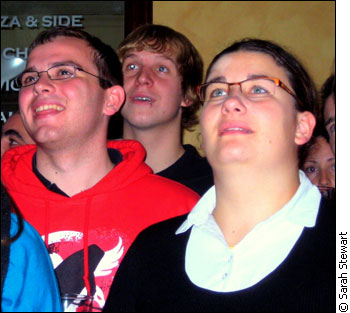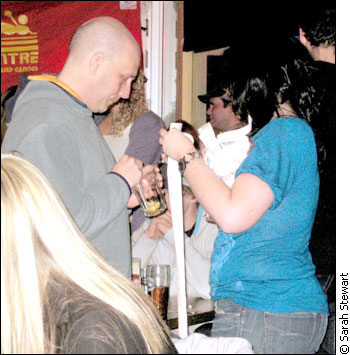Tags
Related Posts
Share This
Ottawa kayakers fight the current, with a new kind of promotional video
Ottawa kayakers are bringing the rapids to a TV or computer screen near you.
In years past, groups of professional kayakers have combined love of sport with the arts, to produce kayaking documentary films that are meant to attract sponsors and create buzz. With the ever-growing power of the Internet, these films have become key for a kayaking career.
Traditionally, these films have been an hour long and available for sale, either online or at kayaking stores like Paddle Shack. But now, world-champion kayaker Joel Kowalski has broken the mould. His latest film, Stakeout, is just over 17 minutes long and is available for free on the Internet.
“If the hype is as big as we think it is, there are a lot of paddlers out there, and they’ll probably all want to download this movie,” said Kowalski.

Enthusiasts watch Stakeout at its Ottawa premier, at Bank Street’s Corner Bar and Grill.
Stakeout features nine kayakers, including Kowalski, riding some of the world’s tallest river waves, in Quebec. These waves and well-known kayakers gained the film a lot of attention, said Kowalski.
The film premiered internationally to an audience of 400 at a kayaking competition in Switzerland in September 2009. But the film’s trailer on YouTube has been viewed nearly 16,000 times.
Stakeout proves that short, fast-paced, free films can attract the attention of sponsors and fans.
“Usually you end up skipping to the part you like,” said Ben Marr, who also helped to create the film. “You watch Stakeout and it’s pure, it’s free, and you just watch it and ‘go kayaking,’ and you’re super excited.”
Since Stakeout is a shorter film, Kowalski said he wanted not too many companies as sponsors. One was Ottawa Kayak School and Tribe, a kayak-themed clothing company.
Stakeout proves that short, fast-paced, free films can attract attention of sponsors and fans.
To sponsor a film or a kayaker means that the company provides gear and helps finance the film, or paddler, explained Tyler Lawlor, who co-owns Level Six, a kayaking gear and apparel company. In return, the sponsor’s gear, replete with the company logo, gets exposure every time someone watches the film.
Typically, kayakers approach the sponsor with a proposal for their help. However, Marr and Kowalski said that Stakeout‘s popularity has brought would-be sponsors to them, to inquire about their next project. “They see it’s free and they want to be a part of that,” said Marr. “Especially because it’s brand new, no one’s done this before. Sponsors want to be a part of it.”

An equipment raffle enlivened Stakeout‘s Ottawa premier.
Let’s make a movie
The filmmaking is no easy process. Stakeout took over two years to make. Of that time, Kowalski said, only four months was dedicated to filming.
The average kayaking movie costs between $10,000 to $15,000 to create. The costs come from cameras, computer software and travel expenses, said Kowalski.
“The hard thing about kayaking is it’s not that big a sport, so you don’t get sent cameras and videographers,” said Marr. “If you were, they might not be able to get down the same rivers.”
The kayakers need to be knowledgeable in every aspect of filmmaking, said Marr. This poses a learning curve for most kayakers, reasonably enough.
Stakeout is not Marr’s only film this year. Marr also had a segment in Valley High, a kayak movie that premiered in Ottawa last November.
Valley High, co-produced by Tyler Fox and Blake Mahoney, is a 40-minute kayak film featuring rivers from all over the globe. It was the first time either kayaker had made a film.
“We learned as we went,” said Mahoney. “There were some pretty painful processes and some pretty hard times, but we managed to get through it.”
Valley High sells for about $30 online and in kayaking stores, said Mahoney. The films don’t generate any profit from movie sales. The sales income simply helps cover production costs, such as travel and printing DVDs, said Mahoney. As of November 2009, Fox said they had sold about 300 copies of Valley High.
Getting the right exposure
Kayakers aren’t into filmmaking for the money. They create movies to get exposure for themselves and their sponsors.
Once the films are finished, the kayakers involved send their footage to current and new sponsors. If the companies like what they see, they send the athlete gear, and occasionally the money, to enable future exploits and filmmaking.
Kayakers sending their videos to sponsors is a new trend, which has emerged in the last two years, said Lawlor. He said the footage is used on the company’s website to promote their gear.
“Videos are good; videos are fun,” said Lawlor. “It brings the kayaker to the community.”
Another way for kayakers to gain exposure is to enter their films at extreme-sport film festivals.
Meagan Stewart works with the Banff Mountain Film Festival. She coordinates two tours call Radical Reels and the Banff Mountain Film Festival World Tour. She said these festivals take the best sport films submitted and play them for audiences around the world. The tour helps filmmakers, because it increases their exposure and connects them with commercial opportunities, said Stewart. She looks for films that are shorter, and she shortens longer films, because shorter ones succeed better.
With the Internet and YouTube now essential as film venues, more kayakers are bound to follow Kowalski’s lead, making videos that are shorter, faster, and, most importantly, free.
“I was inspired by the movies I had seen,” said Kowalski. “I hope people who watch my films get the same feeling I did when I was watching kayaking movies growing up.”
Related Links





